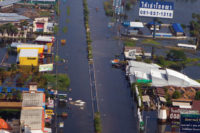Crisis on Campus










When responding to a large loss, it is vital to have a solid plan of action, which begins with a thorough inspection of the damage. Having a complete understanding of the construction techniques and materials used and the main purpose of each building is essential. Planning for disruptions in supply lines - including labor, materials, clean water, power and food - are all critical factors to overcome if one is to manage the mitigation effectively. These factors will play together in establishing a scope of work and a well-developed plan of action.
It is true that no two claims are alike, however, many smaller claims become routine for mitigation companies. Large losses are rarely, if ever, routine, especially when it involves a sprawling campus. Every large loss has its own unique challenges and demanding timelines.
Case in point: In late August 2011, Hurricane Irene drenched the northeast coast of the United States, releasing over eight inches of rain onto Somerset, NJ, causing all creeks, streams, rivers and canals to overflow their banks. Nivek was asked to inspect an area college that had flooded and advise the administration on its best course of action.
The flood waters breached the protective levee and flooded the basement and ground floor of every building, ranging in height from five to eight feet. A quick tour of the campus revealed that there were 16 total buildings damaged. Some of the damaged buildings included an administrative building, chapel, cafeteria, dormitory and gymnasium. Each building has its own unique style of construction to complement its purpose and is comprised of various materials that were typical during the time period when it was constructed.
When dealing with flood waters, there are several unique factors to consider. For instance, any amount of contaminants could be present in the waters. A general inspection of every building should include identifying environmental contaminants such as lead, asbestos, fuel oil and other chemicals, while also looking out for natural hazards such as snakes, poisonous spiders, rodents and other creatures seeking shelter from the rising waters. Other considerations include the type of construction and building materials damaged as well as the historical significance of the structure. Building materials can vary from common drywall to wood, plaster, concrete masonry unit (CMU), brick, steel and even stone. Drying times vary for each material. Knowing what requires drying, and how it typically responds, is valuable information when establishing a mitigation plan. If the building has historical significance, this may impact the demolition of wet materials, thereby extending drying times for the building.
College campuses are unique and comprised of a wide range of buildings that include office space, dormitories and public facilities such as gymnasiums, libraries and cafeterias. Because of their uniqueness, each building requires its own mitigation plan. First, each building was inspected for structural soundness to ensure the safety of restoration workers. Nivek requested the college identify its priorities, time constraints and requirements for each building so a mitigation plan could be determined. The extent and severity of flooding and degree of saturation were documented along with the type of building materials that required drying. Then, a mitigation plan was devised.
Power requirements necessary to dry each building were calculated as was the labor necessary to complete any demolition. The amount of PPE, hand tools, materials, equipment, fuel and food were all determined as was the logistics on how to transport it and the labor force to and from the work site.
Once the extent of selective demolition was determined for each building, a small army of workers were organized into teams and led by a trained Nivek mitigation specialist. Saturated building materials were removed where possible and the facilities were cleaned of mud and debris. Nivek deployed its generators and installed its own portable electrical distribution system consisting of miles of cabling which stretched neatly to distribution panels that powered over 1,000 air movers and more than 200 dehumidifiers. More than a dozen generators were utilized to power the dozen 7500-cfm desiccant dehumidifiers that pumped 120ºF air at nearly 0% relative humidity into the buildings.
When responding to a large loss it is important to have a complete understanding of multiple factors including: safety of each structure, priorities of the client, what can be restored and what must be removed, how to clean and sanitize each building material, knowing how each material will respond to drying efforts, the size of labor force required to perform the job, power and equipment requirements, availability of labor, materials, food and clean water for drinking and washing. If just one factor is overlooked, it can delay or bring a large project to a stop.
Effective pre-planning on a large loss cannot be overestimated. It could be the single most important factor in the success of a project. Through investigation, complete understanding of the drying and mitigation needs, labor requirements, logistics involved and the priorities of the college, a mitigation plan was developed and executed. The project was completed in 16 days, which allowed the college to begin the rebuilding phase. This would have never been possible without a competent mitigation plan.
Looking for a reprint of this article?
From high-res PDFs to custom plaques, order your copy today!












